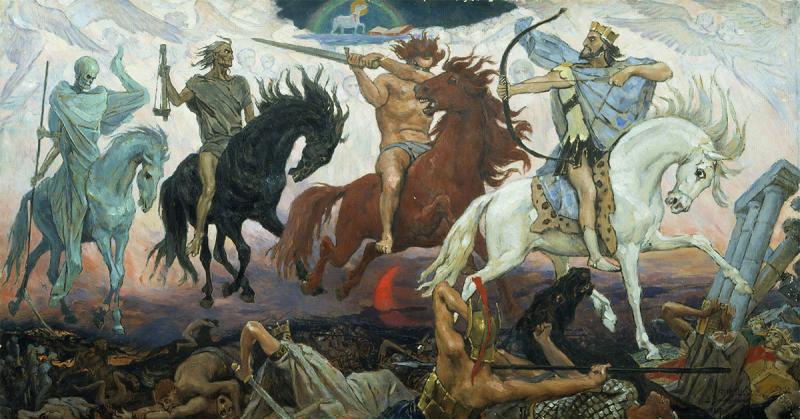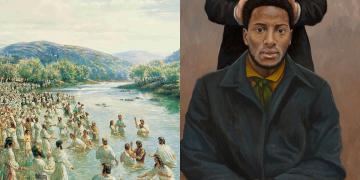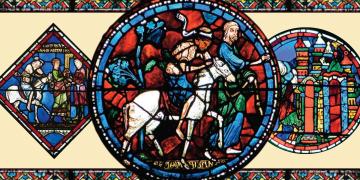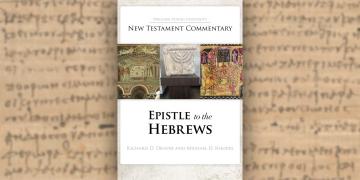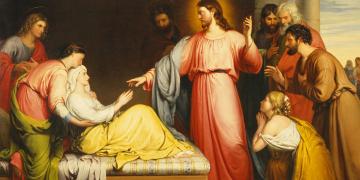You are here
Plagues, Pestilences, Pests and Pandemics in These Latter Days
This is a guest post by Richard Draper, which may also be read at the BYU New Testament Commentary website. Approximate reading time: 12 minutes.
Basically, I am (and have always been) an insecure person seeking for security. At an important point in my life and career, I was introduced to the wonder of scriptural prophecy. It was in an eleventh grade Seminary class where the teacher introduced us to the Revelation of St. John the Divine. He piqued my interest. That interest led me on a journey that eventually took me not only through the wonderful maze of John’s writings and other biblical prophecies but also prophetic statements in the scriptures of the Restoration.
I continue to be intrigued that God not only knows but cares about and shares with his children important information about events that will happen in the future. Working with Michael Rhodes and others on the multi-volume BYU New Testament Commentary, especially immersing myself again in the Book of Revelation, helped to focus and refine my understanding of what God has revealed about the last days.
Out of all this study came an even greater appreciation of the importance of prophecy not only for humankind but also for God himself. In fact, foreseeing and foretelling are two of the ways God proves He is God. In his admonition to the Israelites to believe, trust, and follow him, He declares that He has revealed the future to them. Those prophesied events, He points out, have since come to pass. Their reality is proof, He insists, that He is the one and only God (see Isaiah 43:11–13; 48:3–6).
Given the importance of this ability and power to him, it is little wonder that God is very jealous (in the good sense) of its use. Thus, He forbade Israel from following the practices of those nations who tried to imitate his power (see Deuteronomy 18:9–13, the main passage in the Hebrew Bible that defines the nature of and lists the punishment for those to practice of false prophecy).
The Book of Mormon denigrates those who promulgate false prophecy and those who follow them (see, for example, Words of Mormon, 1:15–16; Helaman 13:25–28; 3 Nephi 14:15; 4 Nephi 1:34). It also highlights authentic predictions given by the prophets Nephi, Zenos, Abinadi, Nephi (the son of Helaman), and Samuel the Lamanite that were precisely fulfilled at the birth and death of Jesus Christ and beyond.
In this regard, one important way in which the Book of Mormon teams up with the Bible and also with the Doctrine and Covenants is in forecasting that various catastrophes, plagues, pestilences and pests are to be expected as signs, especially of the very last of times. Some of these are natural phenomena that God may or may not choose to interfere with. Others are consequences that God may be causing, directly or indirectly. But in all cases, He no doubt can make things less extreme or severe than they otherwise might be. In biblical times, famines were common and caused widespread suffering, starvation, and death, but God warned people to save during years of plenty in order to survive the years of pests, crop failures, and famine. By that means they could survive until the windows of heaven would be open again.
The Book of Mormon speaks not only of then present famines and afflictions (for example, in Helaman 11:1-18), but most especially about events that lie still in the future. For example, in 2 Nephi 6:15–18, the prophet Jacob speaks of the latter-day gathering of Israel and promises that God will protect those who believe. But of those who do not, He states that they “shall be destroyed, both by fire, and by tempest, and by earthquakes, and by bloodsheds, and by pestilence, and by famine. And they shall know that the Lord is God, the Holy One of Israel.”

The famine in the book of Helaman. "El Señor hiere la tierra a causa de la iniquidad" by Maria Vargas, submitted to the 2020 Book of Mormon Central Art Contest.
And Doctrine and Covenants 84:96-98 puts it this way: “For I, the Almighty, have laid my hands upon the nations, to scourge them for their wickedness. And plagues shall go forth, and they shall not be taken from the earth until I have completed my work, which shall be cut short in righteousness—Until all shall know me, who remain, even from the least unto the greatest.”
To appreciate how the Lord uses prophetic and apocalyptic revelations, we must put them into perspective, first by understanding their nature, and second by understanding their purposes.
First, concerning their nature, they can be divided into two distinct types: One type consists of events that will transpire unconditionally, that is, nothing can stop them from happening. Many of these are positive parts of God’s plan for the salvation of his children. For example, the latter-day restoration of the gospel, its spread throughout the world, the consequent gathering of Israel, and the Second Coming of the Lord and His millennial reign.
The other type of prophecies consists of events that will come about only if certain human conditions are met. Interestingly, every frightening prophecy falls into this category. What that means is that these calamities need not come to pass provided conditions that would otherwise trigger them do not happen. A dire prophecy in the Book of Mormon seems to illustrate this point. Three times (in 3 Nephi 16:8–10; 20:15–18; 21:11–16), Jesus warns that if the “if the Gentiles do not repent after the blessing which they shall receive, after they have scattered my people” then shall “a remnant of the house of Jacob, go forth among them” like a young lion among a flock of sheep that “both treadeth down and teareth in pieces, and none can deliver.” Though it is possible that this prophecy could yet be fulfilled, it seems more likely that the necessary conditions were never met. Even though the early LDS Church was persecuted and driven, enough “gentiles” responded to the gospel to nullify the conditions that would have otherwise triggered the fulfillment of the prophecy.
Unfortunately, it would appear that most of the other dire prophecies will not have such a positive ending, and thus the world may yet see plenty of plagues, pestilences, and pests. And why? One of the most frightening insights in answer to this question is found in the book of Revelation. In chapters 8 and 9, using the power of apocalyptic symbolism, John records the vast devastations that will take place preceding the Second Coming. These fall into two categories: the first is the collapse of the natural order, bringing with it huge destructions; and the second is the ensuing wars. After describing the slaughter these wars will bring, the revelation of the Apostle John states that, “the rest of humankind, who had not been killed by these plagues, did not repent of the works of their hands so that they would not worship the demons and idols of gold and silver and bronze and stone and wood, that cannot see, hear, or walk. And they did not repent of their murders, drug use, immorality or stealing” (Revelation 9:20–21; that’s my translation, as rendered in the BYU New Testament Commentary). It is that hard heartedness, that total recalcitrance, and that desperate clinging to an immoral lifestyle even in the face of its consequences that brings about the devouring of the nations by plague, pestilence, and pests.
As an aside, the English word “pestilence” comes from the Latin pestis which denotes “a deadly contagious disease” usually initiated by insects or vermin. However, Joseph Smith seems to have understood the word differently. Doctrine and Covenants 63:24 states that “this is the will of the Lord your God concerning his saints, that they should assemble themselves together unto the land of Zion, not in haste, lest there should be confusion, which bringeth pestilence.” Haste does not usually bring infectious disease, but it does bring calamity and destruction, which the Saints indeed did experience.
This also seems to be the word’s intent in 2 Nephi 10:6, which, concerning the Jews, states “because of their iniquities, destructions, famines, pestilences, and bloodshed shall come upon them; and they who shall not be destroyed shall be scattered among all nations.” Again, the usual definition of “pestilence” does not seem to apply in this verse, but the idea of some type of far reaching devastation certainly does. When Nephi, the son of Helaman, smote the earth in his area with “pestilence” (Helaman 10:6), it manifested itself as a very deep, long lasting famine.
Thus, it would seem that the word “pestilence,” in Joseph Smith’s usage, described cataclysms that are both pernicious and far reaching in nature and brought about due to deep wickedness. They could be brought about by natural phenomena, climate change, insects, pests, or other means, but in the Book of Mormon pestilence was allowed to spread when the Nephites refused to hear their prophets and began to fight among themselves. This comports with John’s conclusion, in Revelation, that pestilence comes when a large segment of society falls away from God and his teachings.
We recall likewise the statement by Paul, found in 2 Timothy 3:1–5, that “in the last days perilous times shall come. For men shall be lovers of their own selves, covetous, boasters, proud, blasphemers, disobedient to parents, unthankful, unholy, without natural affection, trucebreakers, false accusers, incontinent, fierce, despisers of those that are good, traitors, heady, highminded, lovers of pleasures more than lovers of God; having a form of godliness, but denying the power thereof.” The real shame and sorrow of the danger and ruin that follows such lifestyles is that the prophesied horror need not happen if members of society as a whole would just repent. And thus, we can understand the nature of these plagues and cataclysms.

The Four Horsement of the Apocalypse by Albrecht Durer. Image via Met Museum.
The second way of appreciating how the Lord uses prophetic and apocalyptic revelations is by understanding their purposes. That purpose is actually twofold:
God’s first purpose in giving these prophecies is to keep His Saints and faithful followers aware of the pace and direction of current events so that they may know how to prepare. These warnings are often called “the signs of the times.” According to Doctrine and Covenants 45:39: “It shall come to pass that he that feareth me shall be looking forth for the great day of the Lord to come, even for the signs of the coming of the Son of Man.” Further, Doctrine and Covenants 68:11 states, “Unto you it shall be given to know the signs of the times, and the signs of the coming of the Son of Man.” And finally, Doctrine and Covenants 106:4–5 states that “the coming of the Lord draweth nigh, and it overtaketh the world as a thief in the night—Therefore, gird up your loins, that you may be the children of light, and that day shall not overtake you as a thief” (compare also 1 Thessalonians 5:2–5).
In all of these examples, the point is that neither the Second Coming nor the events leading up to it are to take the Saints unprepared.
The second of the twofold purpose of these prophecies is to warn the nations. The Lord states in Doctrine and Covenants 43:25 that He has called upon the nations “by the mouth of my servants, and by the ministering of angels, and by mine own voice, and by the voice of thunderings, and by the voice of lightnings, and by the voice of tempests, and by the voice of earthquakes, and great hailstorms, and by the voice of famines and pestilences of every kind, and by the great sound of a trump, and by the voice of judgment, and by the voice of mercy all the day long, and by the voice of glory and honor and the riches of eternal life, and would have saved you with an everlasting salvation, but ye would not!”
This scripture lists the many ways and means through which God has reached out repeatedly to his children. It shows that He has used both the carrot and the stick. Unfortunately, as noted above, unrepentant wickedness will demand the use of the stick. Therefore, the Lord states in Doctrine and Covenants 43:26, “Behold, the day has come, when the cup of the wrath of mine indignation is full.”
A very graphic description of those dire consequences can be in found in Doctrine and Covenants 29:14–20. There the Lord speaks of both heavenly and earthly signs, including the falling of stars, a great hail storm, and then notes that, because people will not repent, “I the Lord God will send forth flies upon the face of the earth, which shall take hold of the inhabitants thereof, and shall eat their flesh, and shall cause maggots to come in upon them; And their tongues shall be stayed that they shall not utter against me; and their flesh shall fall from off their bones, and their eyes from their sockets; And it shall come to pass that the beasts of the forest and the fowls of the air shall devour them up.”
Here we see pestilence at its very worst, as a plague brought on through vermin and insects, with these very nasty “flies” and maggots, whatever they may be, doing their assigned work.
The Lord has revealed all this for a purpose: as a warning to the world and also to his Church. To us, He has stated very clearly in Doctrine and Covenants 97:25–26, “Zion shall escape if she observe to do all things whatsoever I have commanded her. But if she observe not to do whatsoever I have commanded her, I will visit her according to all her works, with sore affliction, with pestilence, with plague, with sword, with vengeance, with devouring fire.”
Given the attitude, counsel, and instructions from leaders of The Church of Jesus Christ of Latter-day Saints today, it appears the Church has successfully dodged that bullet so far. Our leaders exude optimism and encouragement. Reflecting this is a statement made by President Dallin H. Oaks on March 14, 2020. He stated, concerning our present distress, that “This is not the end of the world but merely a test. A trial run for the Second Coming if you will—physically and spiritually. If you’ve been following the counsel from the prophet about ministering, emergency preparedness, and at-home Church, you have no need to fear, you passed the test.”
His statement does not mean that people don’t need to be careful and diligent. Indeed, they must do all they can to be both prepared and protected. As Joseph Smith explained “concerning the coming of the Son of Man, [that] it is a false idea that the Saints will escape all the judgments, whilst the wicked suffer; for all flesh is subject to suffer, and ‘the righteous shall hardly escape;’ still many of the Saints will escape, for the just shall live by faith; yet many of the righteous shall fall a prey to disease, to pestilence, etc., by reason of the weakness of the flesh, and yet be saved in the Kingdom of God. So that it is an unhallowed principle to say that such and such have transgressed because they have been preyed upon by disease or death, for all flesh is subject to death.” (History of the Church 4:11).
The persistent point is that the Saints are to be wise and should protect themselves by being independent of all adverse influences and by following sound procedures of spiritual and temporal preparation.
The work of the team of scholars who are preparing the BYU New Testament Commentary volumes has made us very aware that there is no doubt that we all are in for a rough time, but the righteous will be spared from the worst of it. My hope and very optimistic outlook rests fundamentally on three scriptures.
The first is Amos 3:7, which states God will do nothing but He reveals His intent to His servants the prophets.
The second is the encouragement found in Doctrine and Covenants 106:4–5, “the coming of the Lord draweth nigh, and it overtaketh the world as a thief in the night—Therefore, gird up your loins, that you may be the children of light, and that day shall not overtake you as a thief.”
And, finally, the third comes from Doctrine and Covenants 38:30, “If ye are prepared, ye shall not fear.”
Through prophesy, a merciful and generous Heavenly Father has shown His Saints and all His children here on this earth who have ears inclined to hear, how He can and will thus protect them in the last days from the plagues, pestilences, and pests that certainly will appear.

John W. Welch, "Destruction in Jerusalem," in Charting the New Testament, chart 3-11.
The new English rendition of the Greek of the Book of Revelation is available FREE: https://byustudies.byu.edu/byu-new-testament-commentary#new-renditions
Order the full BYU New Testament Commentary on Revelation here: https://byustudies.byu.edu/content/new-testament-commentary-revelation-j...
Subscribe
Get the latest updates on Book of Mormon topics and research for free


